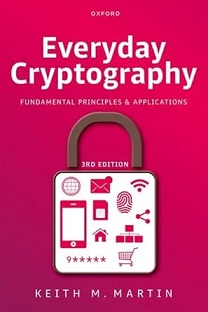The
third edition of Everyday Cryptography was published in July
2025.
In 2012 I completed a
fairly long-running project to provide a book that supports
the Royal Holloway MSc module Introduction to Cryptography and
Security Mechanisms. The first edition of Everyday
Cryptography was published by Oxford University Press in March
2012.
The second edition, published in 2017, features
updates to key technologies and twenty percent new material on
the likes of Tor, bitcoin, TLS 1.3, iPhone cryptography,
WhatsApp cryptography, as well as a full chapter on the
control of cryptography (following the Edward Snowden
revelations).
The third edition was published in July 2025, a major
rewrite designed to include significant new material without
overly increasing the length of the book. The main new
additions relate to:
- Technological
evolution: Some technologies discussed in the book
have evolved. There is new material on, for example, WPA3,
5G security and contactless
payment security.
- Best practices:
Several best practices are rising in importance. Material
has been added on provable
security (recognising the now default demand for
formal evaluation of new cryptographic mechanisms),
different uses of asymmetric cryptography for key
exchange (recognising the increased demand for
perfect forward secrecy), Let's
Encrypt (recognising new options for public-key
certification) and an entirely new
chapter has been added on implementation of cryptography
(recognising an increase in awareness of the sensitivity
and critical nature of cryptographic implementations).
- Quantum
computing: While cryptographically relevant quantum
computers remain far from development, new material has
been added on post-quantum
cryptography and possible implications of future
developments.
- Emerging
themes: An increased societal demand for privacy has
motivated an entirely new
chapter on cryptographic privacy-enhancing technologies.
New material has also been added on ransomware.
Although there seem to
be dozens (well, easily over 100) existing books on
cryptography, most of these fall into several camps. Either
they are:
- Mathematical in their emphasis and designed to
support courses aimed at mathematical science students,
largely through details of algorithms and protocols. These
books are often inaccessible for students from broader
backgrounds.
- Introductory books that lack perspective on the
application of cryptography.
- Specialist books aimed at narrow applications or
aimed at research.
So, Everyday
Cryptography is aimed to fill this "gap" in the
market, and I hope it will be of interest to a range of
audiences, from information security professionals who want an
"entry" guide to cryptography through to the mathematical
science students who want some more application perspectives
on cryptography.
For more information about Everyday
Cryptography:
Reviews of the first
edition and related links:
|
